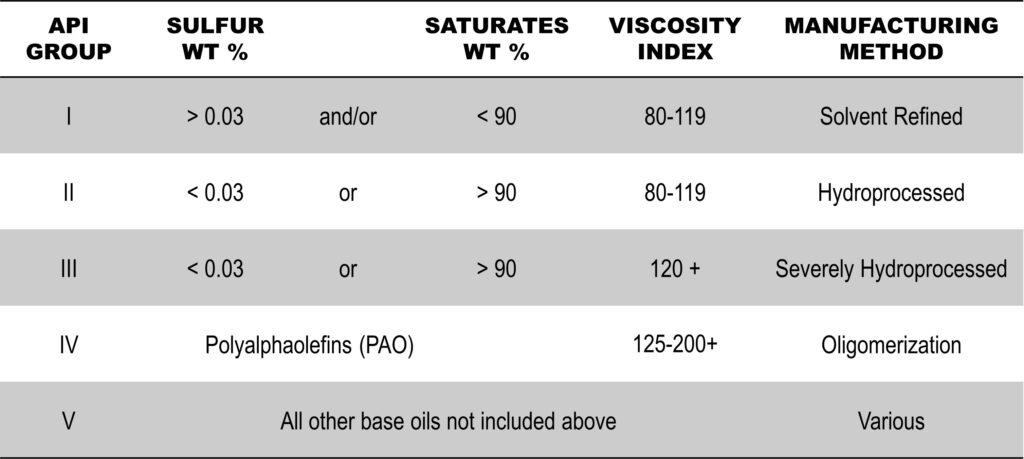Synthetic Base Oils
base oil groups
There are five base oil groups as designated by the American Petroleum Institute. This classification system focuses on the paraffin and sulfur content and degree of saturation of the oil. Essentially, synthetics are can last longer and perform better because they’re more resistant to chemical degradation.
Groups I through III base oils are mineral oils while Groups IV and V base oils are fully synthetic. However, due to a 1999 landmark court case, oil manufacturers are allowed to call oils formulated from Group III base stocks synthetics due to very high viscosity indices.

Synthetic Base Oils
Polyalphaolefins (PAO)
PAOs are the largest group of synthetic oils and are most commonly used as mobile and industrial lubricants.
Pros:
- Low pour point
- Long oxidation life
- Lower volatility
- High Viscosity Index
- More energy efficient
Cons:
- Limited biodegradability
- Cost not conducive for once-through systems or leaking systems
Diesters
Diesters are like PAOs, but with good biodegradability (so not good in water or humidity). These oils are commonly used in air compressors and engine oils because it helps with solvency. This oil is not compatible with some elastometric seal materials.
Pros:
- Long oxidation life
- Lower volatility
- High Viscosity Index
- Good biodegradability
Cons:
- Bad hydrolytic stability
- Limited compatibility with seal materials and paints
Polyglycols (PAG)
Polyglycols, also known as Polyalkylene Glycols, can be water-soluble or water-insoluble (oil-soluble). Water-soluble polyglycols are often used as compressor oils (screw and reciprocating), worm gear oils, fire-resistant lubricants, metal working fluids and brake fluids. Water-insoluble polyglycols are commonly used as heat transfer fluids, high-temperature bearing oils and in screw-type refrigeration compressors.
Pros:
- High temperature, low coking tendency
- Better pour point
Cons:
- Water-soluble polyglycols
- Shouldn’t be mixed with mineral oils
- Can negatively impact on paints and seals
- Expensive
- Hydrocarbon soluble
Phosphate Esters
Phosphate Esters have excellent thermal stability and are good for high pressure applications such as hydraulics.
Pros:
- Excellent thermal stability, fire resistance
- Good for high pressures
- Excellent anti-wear
Cons:
- Very expensive
- Low viscosity index
- Limited seal material compatibility
- Not miscible with mineral oils
- May attack some metal surfaces, paints
Polyolesters
Polyolesters are often used in jet engines or refrigeration compressors with CFC replacement refrigerants.
Pros:
- High temperature stability
- Low volatility
Cons:
- Limited compatibility with seals and paints
- Poor hydrolytic stability and hygroscopic in nature (can absorb moisture from the atmosphere)
Silicones
Silicone oil is also commonly used as the working fluid in dashpots, wet-type transformers, diffusion pumps and in oil-filled heaters.
Pros:
- High viscosity index
- Low pour points, good low temperature fluidity
- Fire resistant
- Water repellent
- Low volatility
- Great oxidation stability
Cons:
- Extremely high cost
- Worst mixed film lubrication properties
- Not miscible with mineral oil and additives
- Forms formaldehyde gas when overheated
Comparative Characteristics

As shown, synthetic oil types have different advantages and disadvantages. When testing synthetic oils, be sure to match the test slate to the type of oil. For example, if a synthetic oil has excellent varnish resistance, testing for varnish would not be a high priority unless there’s a reason to suspect this is an issue (e.g. two oils were mixed inadvertently).
